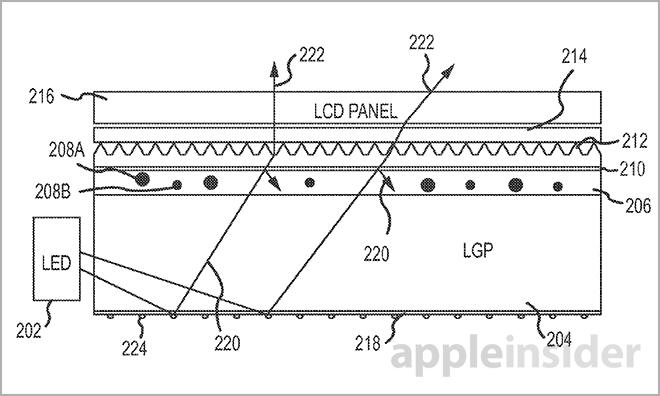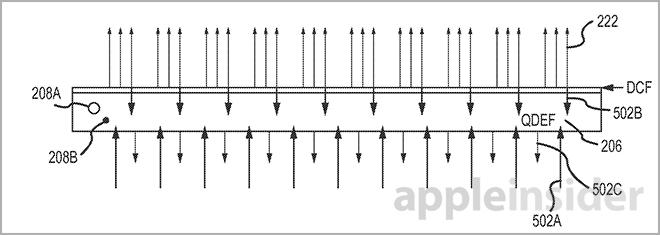An Apple patent application published on Thursday reveals the company is actively researching advanced quantum dot-enhanced displays, a next-generation technology that has the potential to reproduce highly accurate and vivid colors.
Apple's patent for a "Quantum dot-enhanced display having dichroic filter," published by the U.S. Patent and Trademark Office, offers a highly detailed look at both quantum dot tech and how it can be applied to portable devices like the iPhone.
Quantum dots (QDs) are technically nanocrystals - in some cases smaller than a virus - made from various semiconductor materials that exhibit special quantum mechanical characteristics. Of interest to display makers, as well as other industries in the optics field, are QDs' light-emitting properties. Specifically, the material can be "tuned," or manufactured, to emit very narrow spectrums of light.
According to the filing, the electronic properties of QDs are defined by their size and shape, meaning the colors emitted during excitation can be controlled through fabrication. Nanocrystal size and wavelength emission (more accurately bandgap energy) are inversely related, so the larger the QD, the smaller the emission frequency.
Applied to color, bigger dots will skew toward longer wavelengths like red, while smaller dots emit shorter, higher frequency wavelengths like violet. For example, a cadmium selenide quantum dot may be tuned to gradually reproducing the entire visible spectrum, ranging from approximately 460nm (blue) to 650nm (red). This ability to change color by varying nanocrystal size is unlike current phosphor- or organic-based LEDs, which emit light in a fixed spectrum.
In Apple's invention, as with other proposed implementations, a dichroic filter is disposed on a quantum dot-enhanced film (QDEF) in an red/blue/green (RGB) LCD display.
One embodiment calls for a non-QD light source that emits a blue light be combined with a light emitting layer of two QD groups, one red and one green. The layer, possibly a nano-film, is positioned above the first illumination source, thereby absorbing a portion of its blue light to emit red and green light. A second portion of the blue light is allowed to transmit through the QDEF.
The dichroic filter above the QDEF then reflects some of the transmitted blue light back down to be recycled, while allowing an even smaller portion through as white light.
In the embodiment discussed at length in patent application's body, the display also implements an LCD that controls passage of the aforementioned white light through color filters arranged in subpixels. This would provide extremely accurate color reproduction.
A less confusing way to imagine Apple's invention would be to follow light emitted by the LED backlight unit. First, a normal blue LED emits light that is sent to a light guide panel. The LGP evenly distributes the light to the back of an LCD panel with color filters arranged in subpixels.
At this point, instead of using phosphors to produce red and green light, the QDEF's quantum dots are brought to photoluminescence by the blue light, which consequently produces red and green light. The dichroic filter then reflects some of the blue light transmitted through the QDEF back to the QDEF, thereby increasing excitation and red/green output.
Color gamuts of QDEF displays compared to sRGB and Adobe RGB.The filing goes on to explain how brightness can be boosted using prisms and other light forming techniques. Also noted in detail are candidate semiconductor materials from which QDs and QDEFs can be fabricated in a non-toxic manner.
It is unclear if or when Apple will use quantum dot technology in its devices, though the company has a history of delivering some of the best displays in the industry. Recently, however, the colors reproduced by the iPad mini with Retina display were found by one study to be less accurate than competing tablets, possibly leaving some room for improvement.
Apple's quantum dot-enhanced display patent application was first filed for in 2012 and credits Chenhua You as its inventor.
 Mikey Campbell
Mikey Campbell





-xl-m.jpg)


-m.jpg)






 Thomas Sibilly
Thomas Sibilly
 Wesley Hilliard
Wesley Hilliard
 Christine McKee
Christine McKee
 Amber Neely
Amber Neely
 William Gallagher
William Gallagher
 Malcolm Owen
Malcolm Owen

 Mike Wuerthele
Mike Wuerthele








15 Comments
Sony is already using quantum dots in its high-end Full HD and 4K TVs to expand the color gamut from sRGB to x.v.color. But it only makes sense if the content is also encoded in a larger color gamut (nor movies, games or TV content is atm.), otherwise the sRGB colors will be "stretched" and become inaccurate. http://www.flatpanelshd.com/focus.php?subaction=showfull&id=1358342209 It could make sense for Apple to use it in for example a 4K display for the Mac Pro or an iPad Pro. Wider color gamuts is mostly for professional use right now.
Yes, john is right. We already seen this technology before and thank god, I have my Sony Bravia 4K ready television. There are rumors about iPhone 6 screen that it will come with a curved shaped screen http://www.onlinephonecontracts.co.uk/blog/iphone-6-come-curved-screen-apple-got-patent-rounded-device/ So, my question is, Is there any chances that Apple may use this 4K technology in his next flagship phone?
The new Kindle Fire HDX tablet also includes a quantum dot display. http://www.nanosysinc.com/2013/11/18/gizmodo-kindle-fire-hdx-7-incredibly-innovative-first-tablet-display-to-use-super-high-tech-quantum-dots/ EDIT: Guess who else filed a patent on a Quantum Dot Display with a dichroic filter ... Samsung. :\ http://www.google.es/patents/US7746423 If it's something that Apple thinks important to pursue perhaps buying Nanosys would be a consideration? Their patent licenses go back as far as the 1990's (Harvard/MIT) according to press releases.
CRT's => Plasmas => LCD's => AMOLED's => Quantum dots displays (QDD)
I’m quite happy that I was right about QD displays and even happier that we’re seeing them in such a short timeframe.